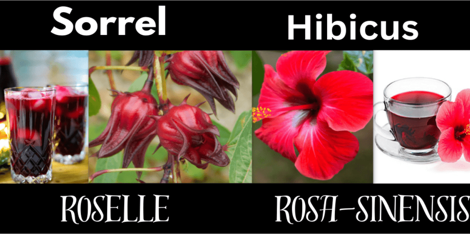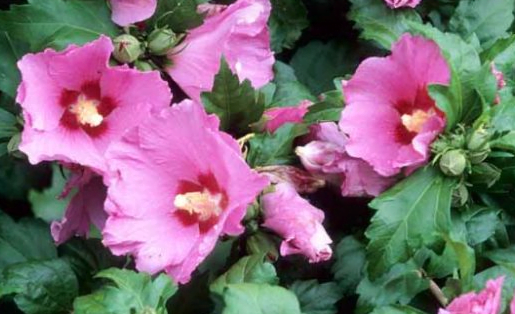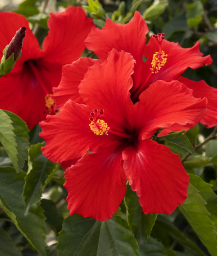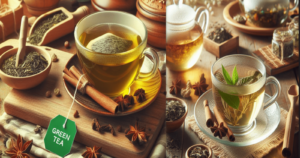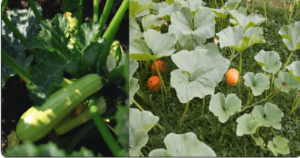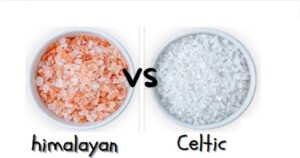Sorrel (Roselle) a relative of Hibiscus and Okra, the leaves are lobed and reddish-green and are edible fleshy, bright red cup-like structure contains the plant’s seeds The color and tart, lemony taste of the calyces makes them a good replacement for cranberries.
Hibiscus is a diverse flowering plants known for their large, flowers that come in a variety of colors, offers a tart, cranberry-like flavor.

What is Sorrel (Roselle)?
Sorrel (Roselle) belonging to the same botanical family as hibiscus and okra, the roselle plant (Hibiscus sabdariffa) shares a kinship with these well-known species. Despite not being indigenous to Florida, it became a staple in many Florida Cracker homesteads, reflecting its widespread cultivation.
Commonly known as Florida cranberry, red sorrel, or Jamaica sorrel, the roselle plant traces its origins to Central and West Africa, yet it has found a home in various regions globally.
The edible part of this plant is the calyx of its distinctive flower, which can be creatively utilized in the preparation of jams, sauces, and teas.

Roselle, a decorative edible plant with kinship to okra, boasts its culinary versatility. While the entire plant is suitable for consumption, it is primarily cultivated for its striking burgundy calyxes that form at the flower base.
These calyxes, originally protective sheaths for the flower buds, transform into a vibrant display post-blossom, characterized by their fleshy and deep red hues.
Harvested for their rich visual appeal, the calyxes serve as the key ingredient in producing a lively red tea, renowned for its tart and fruity notes reminiscent of cranberry, rhubarb, or citrus.
Beyond tea, roselle finds its place in diverse culinary creations, contributing to herbal tea blends and playing a pivotal role in beverages like bissap—the national drink of Senegal, Sorrel beer /sorrel juice a Caribbean Christmas a Drink .
Additionally, roselle extends its culinary influence to jellies, syrups, sauces, and its young leaves, which add a spicy kick to salads or can be cooked as a spinach alternative.
Simple Sorrel drink recipe
Ingredients
1.Sorrel(roselle) buds
2. Cinnamon stick
3. Clove as desired
4. Ginger
5.Orange peel and water
Add water and let come to a boil for 10 minutes and leave over night .Next day add brown sugar taste.
Key Comparison between sorrel (Roselle) and Hibiscus (rosa-sinensis)
| Sorrel (Roselle) | Hibiscus Plant |
|---|---|
| Hibiscus sabdariffa, part of the Malvaceae family, is an herbaceous plant that can be annual or perennial. Its dark green leaves have a distinctive three to five-lobed shape. | Within the Malvaceae family, encompassing numerous flowering plant species. These plants thrive in warm temperate, subtropical, and tropical regions globally, showcasing their adaptability. |
| Flavor and Use: Sorrel (Roselle) fruit have a tangy or sour taste due to oxalic acid. They are used in salads, soups, sauces, jam and herbal teas. Sorrel is also a common ingredient in various cuisines. | Symbolism: The hibiscus symbolizes beauty, femininity, love, and passion. It’s also linked to fertility and life’s cycle, thanks to its abundant blooming, which suggests vitality and renewal. |
| Names: Florida cranberry, Gongura, Guinea/Indian/Jamaican/red sorrel, karkadi (or karkade), lemon bush, natal roselle, Queensland jelly plant, roselle hemp, sorrel, sour-sour, zobo. | Flavor and Use: When the dried petals are steeped in hot (or cold) water, they release a tart, almost-cranberry like flavor and a deep red-violet color that looks more like cabernet than chamomile. |
| Fruit: The fruit is a fleshy red calyx (the outer part of the flower), which is used in culinary and medicinal applications. | Flower Appearance:Hibiscus flowers are large, colorful, and typically trumpet-shaped with five petals, available in a variety of colors like red, pink, orange, yellow, and white. |
| Flowers: The flowers are large and showy, with five petals and a deep red color. | Stamens and Pistil: The prominent stamens and pistil are often fused into a tubular structure, and the stamens form a central “stalk” called a staminal column. |

Physical differences between Sorrel(roselle ) and Hibiscus (rosa-sinensis)?
| Sorrel(roselle ) | Hibiscus (rosa-sinensis) |
|---|---|
| It is an annual herbaceous plant. | It is a woody shrub or small tree belonging to the mallow family (Malvaceae). |
| Typically grows as a bush, usually not as tall as Rosa sinensis. | Can grow into a small tree, reaching heights of several meters. |
| Leaves are deeper green, with a different shape and texture, often with lobes and toothed margins. | Dark green, glossy leaves with serrated edges |
| The flowers are smaller and less showy, typically pale yellow with a maroon or red center. The most commonly used part of the plant is the calyx rather than the flower itself. | Large, showy flowers with a wide range of colors. The flowers are typically single or double-layered. |
| Known for its calyces, which are used to make herbal tea (hibiscus tea), jams, and jellies. It is cultivated for both culinary and medicinal purposes. | Primarily grown for ornamental purposes. It’s a popular choice in landscaping and gardens. |
| Grown infields as a crop. | grown in gardens for its beautiful flower. |
Common names for Sorrel (Roselle) around the world.
This plant is commonly referred to by different names in various regions and cultures.
1. Florida Cranberry: This is a name used for Hibiscus sabdariffa, possibly because of its cranberry-like flavor.
2. Gongura: This is the name used in some Indian regions, particularly in Andhra Pradesh, for the leaves of Hibiscus sabdariffa. It’s commonly used in culinary dishes.
3. Guinea/Indian/Jamaican/Red Sorrel: These are names used in different regions to refer to the same plant. The term “sorrel” is often used in the Caribbean, while “Guinea sorrel” and “Indian sorrel” suggest its use in those regions.
4. Karkadi (or Karkade): This is a name used in Sudan and Egypt for a drink made from the dried calyces of Hibiscus sabdariffa. It’s also known as “hibiscus tea.”
5. Lemon Bush: This name is likely used due to the lemony flavor of the plant.
6. Natal Roselle: This could refer to the plant in the context of its native region, Natal, in South Africa.
7. Queensland Jelly Plant: The plant is known for its jelly-like substance, and this name used in Australia.
8. Roselle Hemp: This suggests the use of the plant for fiber, similar to hemp.
9. Sorrel: This is a general term used in various regions of the Caribbean, and it may refer to different plants depending on the context.
10. Sour-Sour: This is another name used for the plant, likely derived from its tangy or sour taste.
11. Zobo: This is a common name for the hibiscus drink in Nigeria, often prepared with ginger and served chilled.
| Country | Common Names |
|---|---|
| U.S.A | Florida Cranberry, Lemon Bush, Roselle Hemp, Sour-Sour |
| India | Gongura, Indian Sorrel |
| Sudan, Egypt | Karkadi, Karkade, Hibiscus Tea |
| Australia | Queensland Jelly Plant |
| South Africa | Natal Roselle |
| Various Regions | Guinea Sorrel, Indian Sorrel, Jamaican Sorrel, Red Sorrel, Sorrel |
| Nigeria | Zobo |
| Caribbean | Sorrel, red sorrel, Jamaican sorrel |
| KwaZulu-Natal | Natal Roselle |
History and Origin of Sorrel(roselle)
Roselle (Hibiscus sabdariffa) originates from West Africa, and belongs to the genus Hibiscus.
During the 16th and early 17th centuries, it was introduced to Asia and the West Indies or Caribbean Islands where it take on the name Sorrel, Jamaican Sorrel. Over time, it has adapted and become naturalized in various locations across these regions.
In the French West Indies, Roselle (Hibiscus sabdariffa) is referred to as groseille-pays, which translates to redcurrant in French, or as Gwozey-péi in Creole.
Nutritional value of Sorrel(roselle)
The Sorrel Hibiscus leaves are a good source of polyphenolic compounds.Freshly harvested Roselle fruits yield calyces that are utilized to create a beverage rich in vitamin C and anthocyanins.
This flavorful drink is not only refreshing but also provides nutritional benefits, thanks to the presence of these essential nutrients.
| Per 57 g serving. | |
| Calories | 28 |
| fat | 0.4 g |
| protein | 0.6 g |
| Carbohydrate. | 6.5 g |
| Vitamin A | If uncooked contains 7.98 mcg |
| Vitamin C | 6.8 mg |
| Iron | 0.84 mg |
| Calcium | 123mg |
| Potassium | 119mg |
| Sodium | 3.4mg |
| Magnesium | 51 mg |
Can you Eat Sorrel (Roselle)?
Yes most of the Sorrel plant are edible.
the young leaves and tender shoots of the Roselle plant are indeed edible. They can be consumed raw in salads or cooked as greens, either on their own or in combination with other leafy vegetables and meat.
Additionally, the stems of the Roselle plant produce a fiber that can serve as a substitute for jute, commonly used in making burlap. This dual usability—edible leaves and stems for fiber—adds to the versatility of the Roselle plant in culinary and industrial applications.
The most widely edible part of the Roselle plant is the calyx that surrounds the seed pod. It is used in many culinary aspect.
7 Important Health benefits of Sorrel(Roselle)
1. Anti-inflammatory and Anti-bacterial properties
Hibiscus tea is abundant in ascorbic acid, commonly known as vitamin C, an indispensable nutrient crucial for enhancing and activating the immune system. The fresh or dried flowers of roselle are particularly rich in vitamin C.
This tea contributes to fortifying the immune system, preventing colds and flu. Its anti-inflammatory and antibacterial properties further support overall immune health. Additionally, the cooling effect of hibiscus tea makes it beneficial in alleviating discomfort associated with fever.
2. Cough Cold and Fever Management
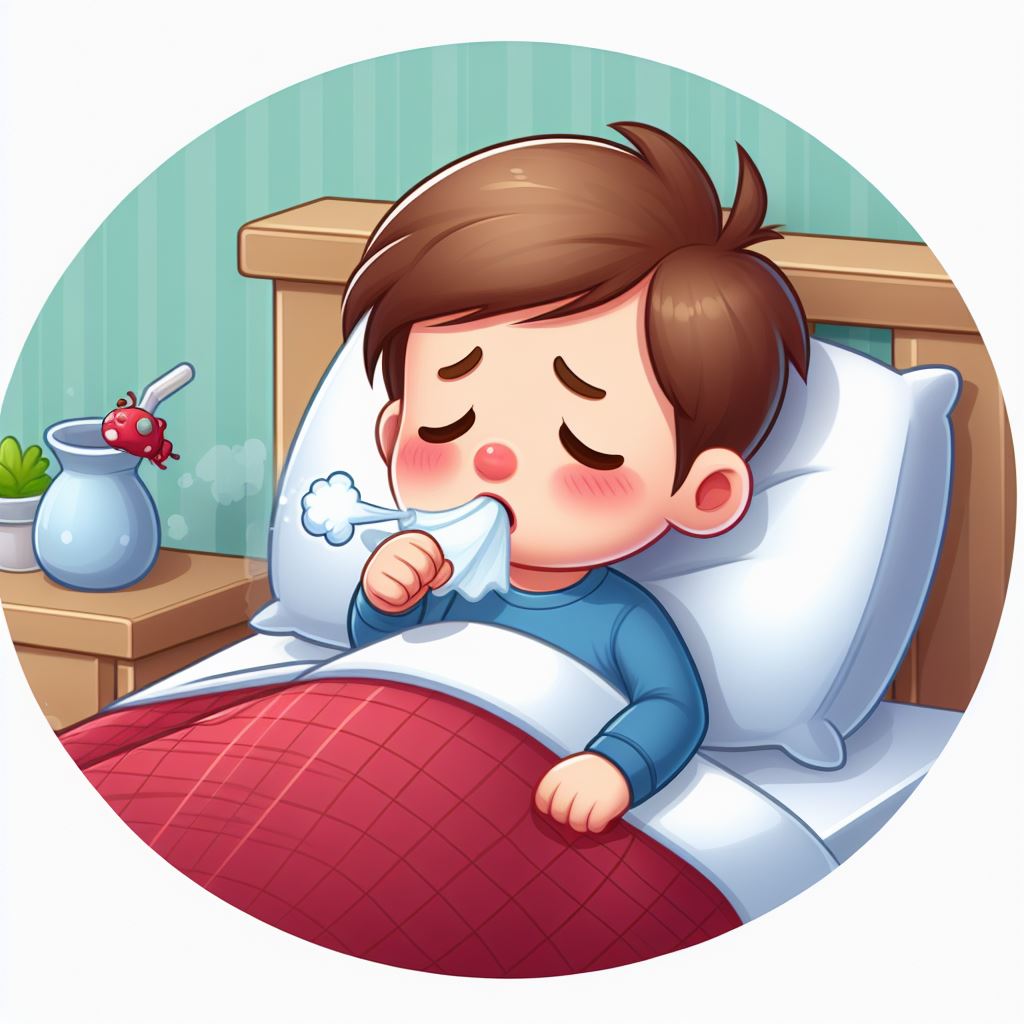
Fresh hibiscus flowers contain approximately 6.7 mg of ascorbic acid, a variant of vitamin C, a crucial nutrient for the body.
Hibiscus is recognized for its positive attributes, including anti-inflammatory and mild antibacterial properties.
Consequently, hibiscus tea is commonly employed as a supplement to address coughs and colds. Its cooling properties make it particularly effective in alleviating the discomfort associated with fevers that often accompany these health issues.
3. Blood Pressure Control
Roselle, also known as Hibiscus sabdariffa or hibiscus tea, has been suggested to have potential benefits for controlling blood pressure. Here’s how it may contribute to blood pressure management:
Antioxidant Properties: Roselle is rich in antioxidants, including flavonoids and anthocyanins. These compounds help combat oxidative stress in the body, which can contribute to the development of hypertension (high blood pressure).
Vasodilation: Some studies suggest that hibiscus tea may have a vasodilatory effect, meaning it can help relax blood vessels. This can lead to improved blood flow and reduced pressure on the arterial walls.
Diuretic Effect: Hibiscus tea has a mild diuretic effect, promoting increased urine production. This can contribute to a reduction in blood volume and, consequently, blood pressure.
Inhibition of Angiotensin-Converting Enzyme (ACE): Some research indicates that hibiscus may have ACE inhibitor-like effects. ACE inhibitors are a class of medications commonly prescribed for hypertension. They work by relaxing blood vessels, making it easier for blood to flow.
Lowering LDL Cholesterol: Hibiscus may also have a positive impact on cholesterol levels. By lowering LDL (low-density lipoprotein) cholesterol, it can potentially reduce the risk of plaque buildup in the arteries, which is associated with hypertension.
4. Anti-depressant Properties
Evidence suggesting that certain compounds found in Hibiscus sabdariffa (roselle) may have potential neuroprotective and anti-anxiety effects. These effects could be attributed to various bioactive compounds, including flavonoids, which have antioxidant properties.
5. Helps to prevent Anemia
Hibiscus sabdariffa, commonly known as roselle, is known to be rich in iron. Iron is an essential mineral that plays a crucial role in various bodily functions, including the formation of hemoglobin, which is responsible for carrying oxygen in the blood. Iron is also important for energy production and the proper functioning of cells.
6. Diuretic Properties
- Diuretics increase urine production and are often used to manage conditions such as edema (fluid retention) and hypertension. If the seed capsule of Roselle indeed possesses diuretic properties, it may contribute to increased urination.
7. Treatment of Constipation
- The fiber content in certain parts of the Roselle plant, including the seed capsule, may have a laxative effect, which could help relieve constipation. Fiber adds bulk to the stool and promotes regular bowel movements.
Some studies suggest that the antioxidants found in hibiscus roselle may have a protective effect on the liver, potentially preventing damage and supporting overall liver health.
However, it’s important to note that research in this area is still in its early stages, and more studies are needed to fully understand the extent of hibiscus roselle’s impact on liver health.
What is Hibiscus (rosa-sinensis)?


Hibiscus is a diverse genus plant that is within the Malvaceae family, encompassing numerous flowering plant species. These plants thrive in warm temperate, sub-tropical, and tropical regions globally, showcasing their adaptability.
Celebrated for their impressive, vibrant flowers, these members of the hibiscus genus are commonly referred to as simply “hibiscus” or alternatively known as Chinese hibiscus, rose mallow, or Hawaiian hibiscus. Additional names for these striking plants include hardy hibiscus, rose of Sharon, and tropical hibiscus.

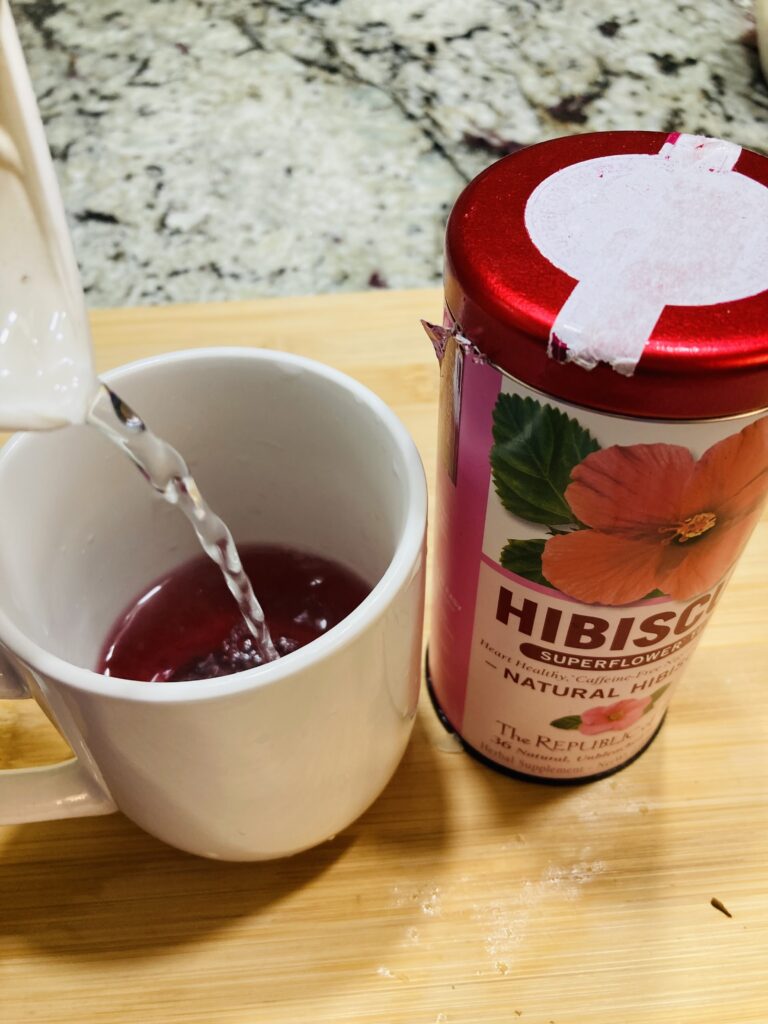
Identifying Types and Variety of Hibiscus (rosa-sinensis)
- Cooperi:
Known for its large, double, bright red flowers.
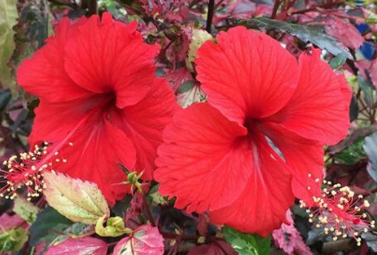
Grown for its stunning variegated foliage and brilliant single red flowers. This heritage variety becomes a captivating focal point in the garden, boasting leaves adorned in a stunning array of burgundy red, pink, white, and green hues.
2. Snow Queen
Features white or cream-colored flowers with a prominent red eye.
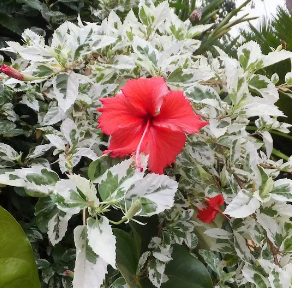
What sets this apart is the presence of distinctive white splashes or on the leaves. These white markings can take various forms perhaps as speckles, streaks, or patches creating an eye-catching contrast against the predominant green background. This adds an ornamental quality to the foliage even before the plant comes into bloom.
3. Double peach hibiscus (Orange Hibiscus)
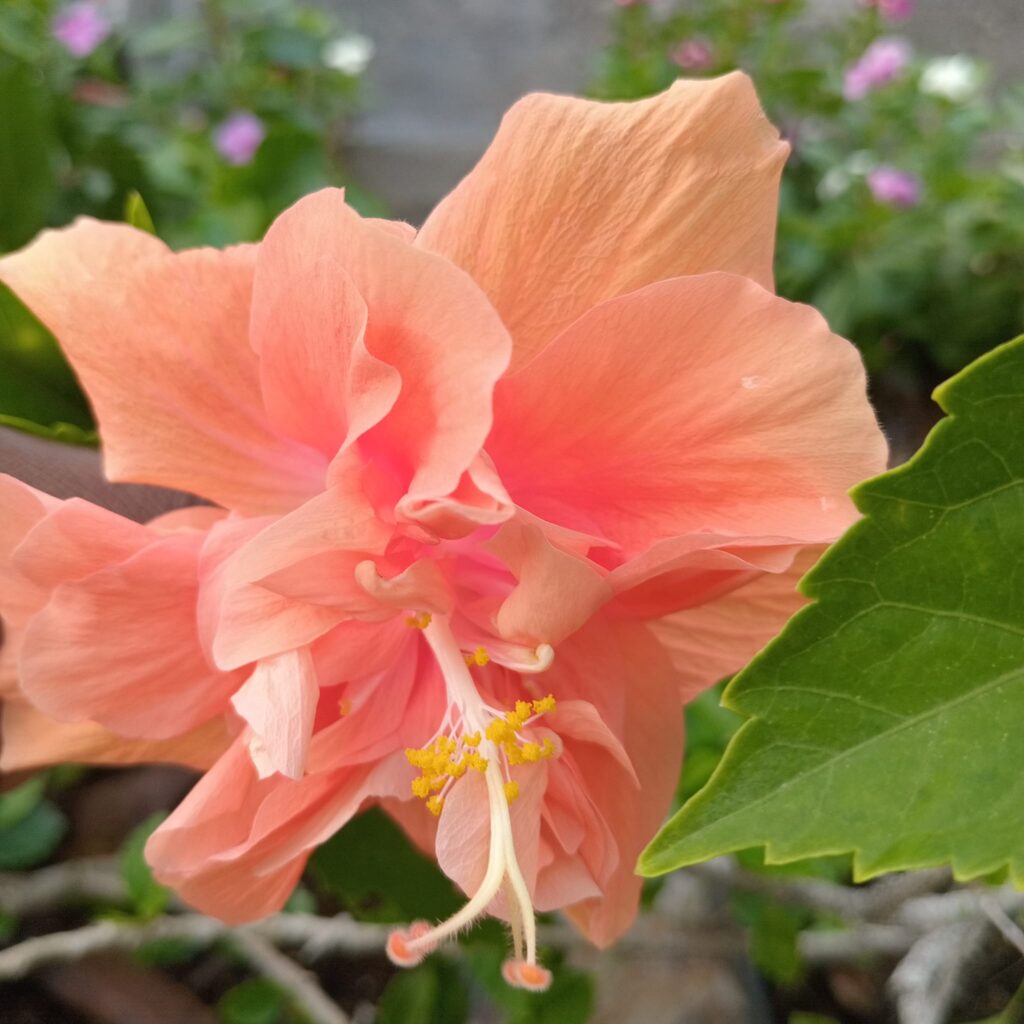
The soft peach color is a common variation, and the prominent stamens and pistil extend outward from the center of the flower, typical of hibiscus plants.
This type of hibiscus is popular in tropical and subtropical regions, often grown as an ornamental plant for its vibrant and beautiful blooms.
Characterized by double, vibrant orange flowers.
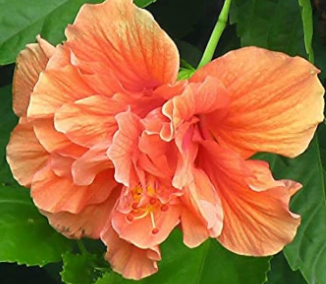
Characterized by its compact and upright form, adorned with stunning large blooms in a vibrant shade of orange.
A fantastic choice for potted arrangements. It’s important to note that proper care is essential, and the plant should not be allowed to dry to the point of wilting to ensure optimal health and blooming.
4. Peaches and Cream
Displays peach-colored blooms with a creamy edge.
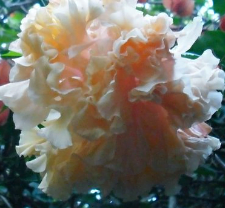
Features large, ruffled blooms that showcase a harmonious blend of soft peach and creamy tones. With a bushy and compact growth habit, Peaches and Cream Hibiscus is versatile, making it suitable for various landscaping applications.
notable for its deep red, almost cranberry-colored flowers.

Disc-shaped flowers, measuring 6-10 inches across, boast five flat and vibrant petals, each spanning 3-4 inches in length.
These petals create a stunning display of colors around a central staminal column that is both prominent and showy. While individual flowers last only one day.
the plant typically produces one or more new blooms each day in a continuous succession from mid-summer to early fall, sometimes lasting until the first frost. With the potential for up to 250 flowers per growing season, the plant presents a prolific and visually captivating spectacle. The glossy dark green leaves, heavily and deeply cut with irregularly serrated edges, feature reddish stems, enhancing the overall appeal of this botanical specimen.
6. Yellow Submarine Or Yellow Hibiscus Butterfly (Hibiscus rosa-sinensis Butterfly’).
Stands out with bright yellow flowers.
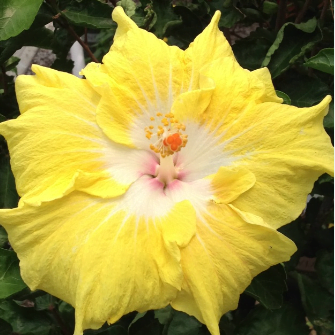
Tropical hibiscus featured for its yellow ,and usually associated with happiness and peace. Grow all year round in Full Sun to Partial Shade. Attracts Bees
Butterflies Hummingbirds. Can be use as a shrub in the garden.
This particular variety is known for its bright yellow petals with a distinct white center, often with a pinkish hue near the base of the petals, and a pronounced stamen with a touch of orange.
The ruffled and somewhat crinkled petals are characteristic of this cultivar, making it a popular choice for gardeners seeking a vibrant, showy hibiscus.


7. Queen of Hearts
showcases large, deep red, double flowers.

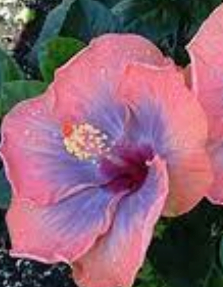
Also known as Hibiscus ‘Voodoo Queen,’ is a fascinating and visually stunning plant. The ability of its flowers to change colors within a single day is indeed a remarkable characteristic.
The flower’s transformation from pink with violet centers and a burgundy heart in the morning to yellow petals with gray-lavender centers and a strawberry heart by the afternoon.
Its large, 7-8″ blooms with vibrant colors and intricate detailing make it a standout feature in any garden or tropical setting.
It’s important to provide the Queen Hibiscus with the right conditions. Full sun exposure, along with ample water and fertilizer, are recommended to maximize its blooming potential.
8. Aphrodite
Features large, single, red flowers with a dark eye.
Also known as Rose of Sharon frilly pink flowers and a rich wine-red center. These eye-catching blossoms stand out against the deep green leaves.
Blooms are around 4-5 inches and last for up to 4 months. The lush green foliage with toothed edges is just as attractive.
This shrub’s upright branches make it great for hedges, screens, borders, or as a garden accent. You can even shape it into a small tree or use it in containers. Once it’s settled, ‘Aphrodite’ handles city pollution and short dry spells. Plus, it works well in various climates.

9. Brilliant
known for its brilliant red flowers and glossy green leaves.
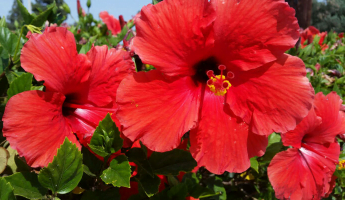
10. Pink hibiscus or Lollipop
Has double flowers in a combination of pink and white.
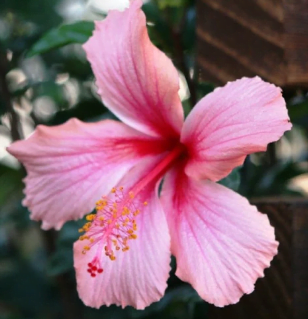
Lollipop, with vibrant pink windmill flowers and a dark center, is perfect for informal hedging and container planting. Ideal for sunny, sheltered spots, it thrives in well-draining, organic-rich soil.
Protect from frost, enjoy humidity, and shelter from strong winds. A striking choice for feature planting. Grow well in tropical climates and can be kept indoor in cold climate.

11. Bluebird
uncommon for its blueish-purple flowers.

Blue Bird Hibiscus is a moderately growing shrub, attaining a height of 6 to 8 feet and a width of 6 feet.
This stunning flowering shrub is known for its sizable blossoms, making it an exceptional choice to serve as a captivating backdrop for beds and mixed borders in gardens.
12. Yellow Butterfly
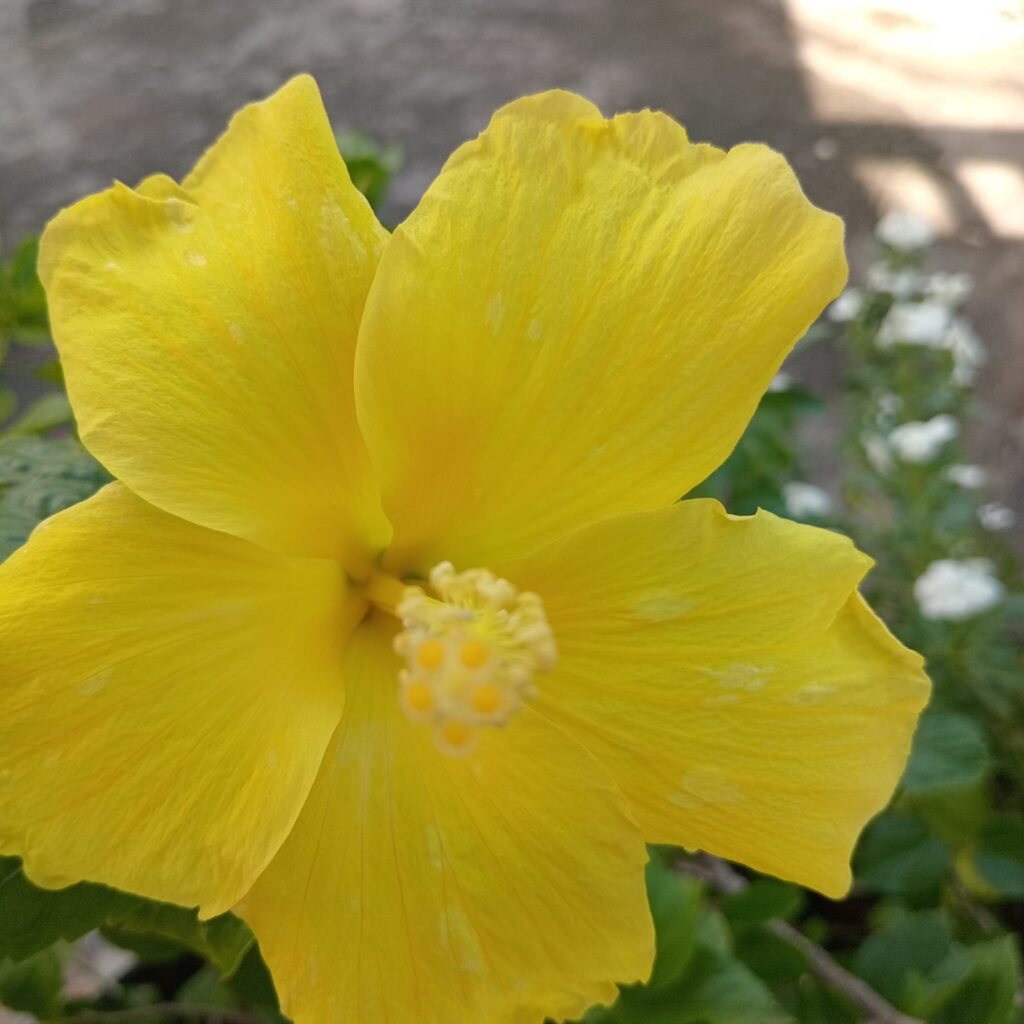
Named for its resemblance to a butterfly, yellow flowers.
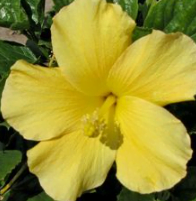
Commonly known as the Chinese hibiscus or shoe flower. An upright shrub that belongs to the evergreen perennial family.
Featuring vibrant and small-sized flowers, grows to a moderate size, forming a well-branched and compact shrub, bloom during the warmer months, typically in spring and summer.
13. Cajun Blue
another variety with blue-toned flowers.
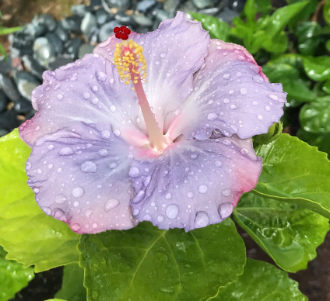
Pale lavender-blue blooms measuring 6 inches, beautifully contrasting with its dark green glossy leaves in an upright growth pattern, captivates us with its distinctive blue flowers optimal conditions involve providing full sunlight, ample water, and regular fertilization to ensure its flourishing beauty.
14. President
Features large, double, deep red blooms.
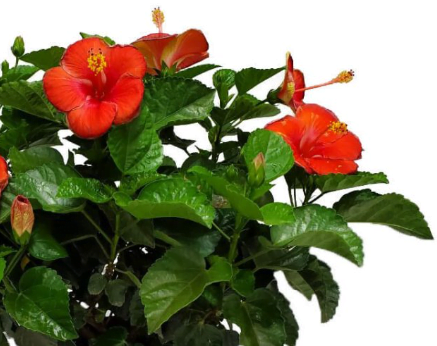

The President Hibiscus boasts an erect stature adorned with magnificent coral-hued blooms, accentuated by deep red centers. It serves as an ideal choice for indoor cultivation in containers, ensuring a stunning addition to your space. Care should be taken not to let the plant reach the point of wilting.
Key Features of President hibiscus.
- Striking coral-pink flowers, rounded in shape, featuring captivating red eyes and adorned with yellow anthers.
- Blooms grace the branches from mid-summer through early fall.
- Glossy, pointed leaves maintain a rich, dark green hue year-roun
16. Moonlight
known for its pale yellow or cream-colored blooms.
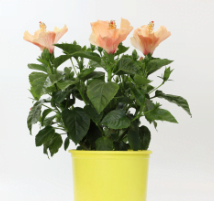

17. El Capitolio
Features large, double flower.

flowers may sometimes sport white streaks emanating from their centers.

Flower Structure: The distinctive feature of ‘El Capitolio’ is its double flower structure, with a main ruffled flower and a smaller frilly double flower at the end of the long stamen.
Poodle-Like Tail Tip: The description of a poodle-like tail tip suggests a playful and unique appearance, adding to the ornamental value of the plant.
Color Variations: While you didn’t specify the color of the flowers, hibiscus flowers come in a wide range of colors. The mention of white streaks suggests that there may be variations in the color patterns.
Growth Habits: ‘El Capitolio’ can be grown both as a container plant and as a large shrub in the landscape. This flexibility makes it suitable for different gardening preferences and spaces.
Sunlight Requirements: The plant appears to be adaptable to different light conditions, thriving in both full sun and partial shade. Ensure it receives adequate sunlight to promote healthy growth and blooming.
Ease of Cultivation: Your description indicates that this hibiscus variety is easy to grow and bloom. This makes it a suitable choice for both experienced and novice gardeners.
Color Variations: While you didn’t specify the color of the flowers, hibiscus flowers come in a wide range of colors. The mention of white streaks suggests that there may be variations in the color patterns.
Growth Habits: ‘El Capitolio’ can be grown both as a container plant and as a large shrub in the landscape. This flexibility makes it suitable for different gardening preferences and spaces.
Sunlight Requirements: The plant appears to be adaptable to different light conditions, thriving in both full sun and partial shade. Ensure it receives adequate sunlight to promote healthy growth and blooming.
Ease of Cultivation: Your description indicates that this hibiscus variety is easy to grow and bloom. This makes it a suitable choice for both experienced and novice gardeners.
18. Coral Hibiscus

This particular variety features a delicate gradient of color, with a peach tone on the petals that gently transitions to a lighter pink near the center. The central stamen is long and prominent, with bright yellow anthers.
7 facts about Hibiscus (rosa-sinensis)?
1. In Indonesia and Malaysia, the blossoms are known as kembang sepatu or bunga sepatu, translating to “shoe flower” in the local language.
2. Hibiscus (rosa-sinensia) the national flower of malaysia.
3. The flower are bisexual
4. In early 19th and 20th centuries decoction of the root of the hibiscus (rosa-sinensis) was use to relieve venereal disease fever and sore eyes.
5. Decoction of the root of the red and white flowered hibiscus plant serve as an antidote for poison.
6. Chinese and Indians use the juice of the petals as dye to darken hair and eye brow.
7. Petal use as black dye in Malaya and Indonesia.
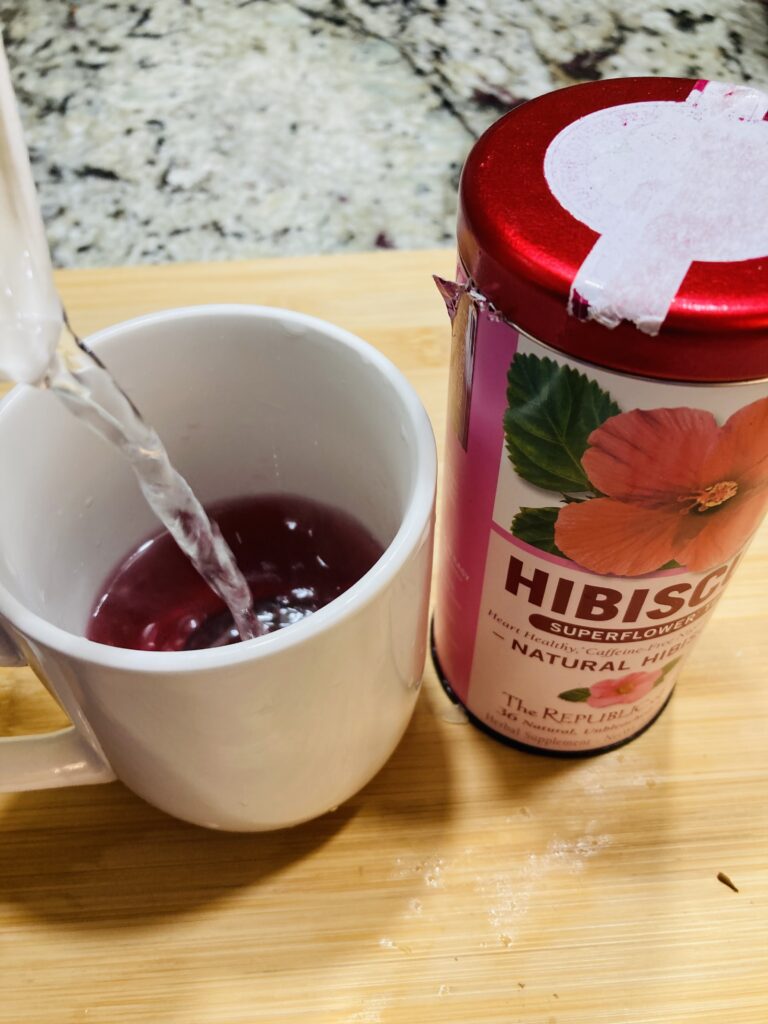
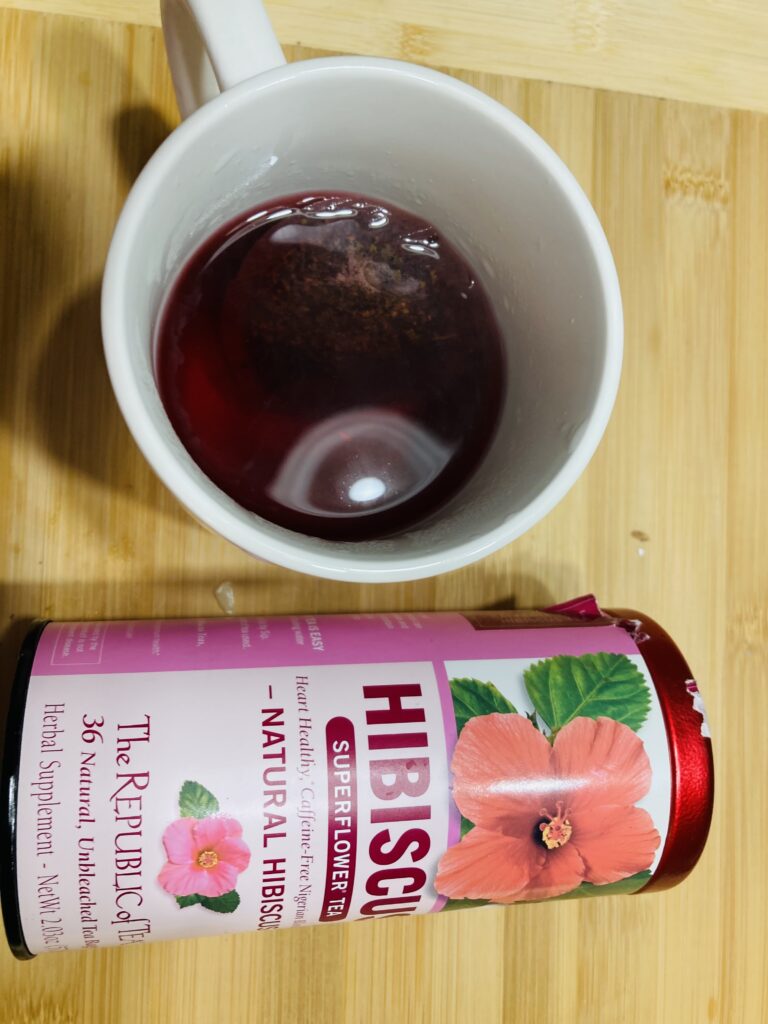
10 Health Benefits Hibiscus (rosa-sinensis)
Rich in Antioxidants: Hibiscus is packed with antioxidants, including flavonoids and anthocyanins, which help combat oxidative stress and reduce inflammation in the body.
Heart Health: Consuming hibiscus tea has been linked to lower blood pressure levels. It may also help lower levels of triglycerides and cholesterol, promoting cardiovascular health.

Weight Management: Hibiscus tea is often associated with weight management. It may help prevent the accumulation of excess fat in the body and contribute to a healthy weight.
Liver Health: Some studies suggest that hibiscus extracts may have a protective effect on the liver, potentially reducing the risk of liver diseases.
Anti-Inflammatory Properties: The compounds in hibiscus have anti-inflammatory effects, which can be beneficial for conditions involving inflammation, such as arthritis.
Digestive Health: Hibiscus may have mild diuretic properties and can be helpful for promoting a healthy digestive system. It may also aid in relieving constipation.
Rich in Vitamin C: Hibiscus is a good source of vitamin C, which is essential for a healthy immune system. Vitamin C also promotes skin health and helps the body absorb iron.

Kidney Health: Some research suggests that hibiscus may have a positive impact on kidney health by preventing the formation of kidney stones and protecting against certain kidney-related conditions.
Anti-Cancer Potential: Preliminary studies indicate that hibiscus extracts may possess anti-cancer properties, although more research is needed in this area.
Do you know the Hibiscus (rosa-sinensis) flowers are Edible
Hibiscus rosa-sinensis, commonly known as the Chinese hibiscus, is a tropical flowering plant that is native to East Asia.
While the plant is primarily grown for its ornamental flowers, it’s worth noting that the flowers of Hibiscus rosa-sinensis are indeed edible, and in some cultures, they are used in culinary applications, including salads.
In the Pacific Islands and other tropical regions, the hibiscus flowers are known to be used in various dishes, adding both visual appeal and a unique flavor.
The flowers have a mildly tangy and somewhat citrusy taste, making them a suitable addition to salads, desserts, and beverages.
Land turtle love to feast on the petals of the Hibiscus (rosa-sinensis) flower.
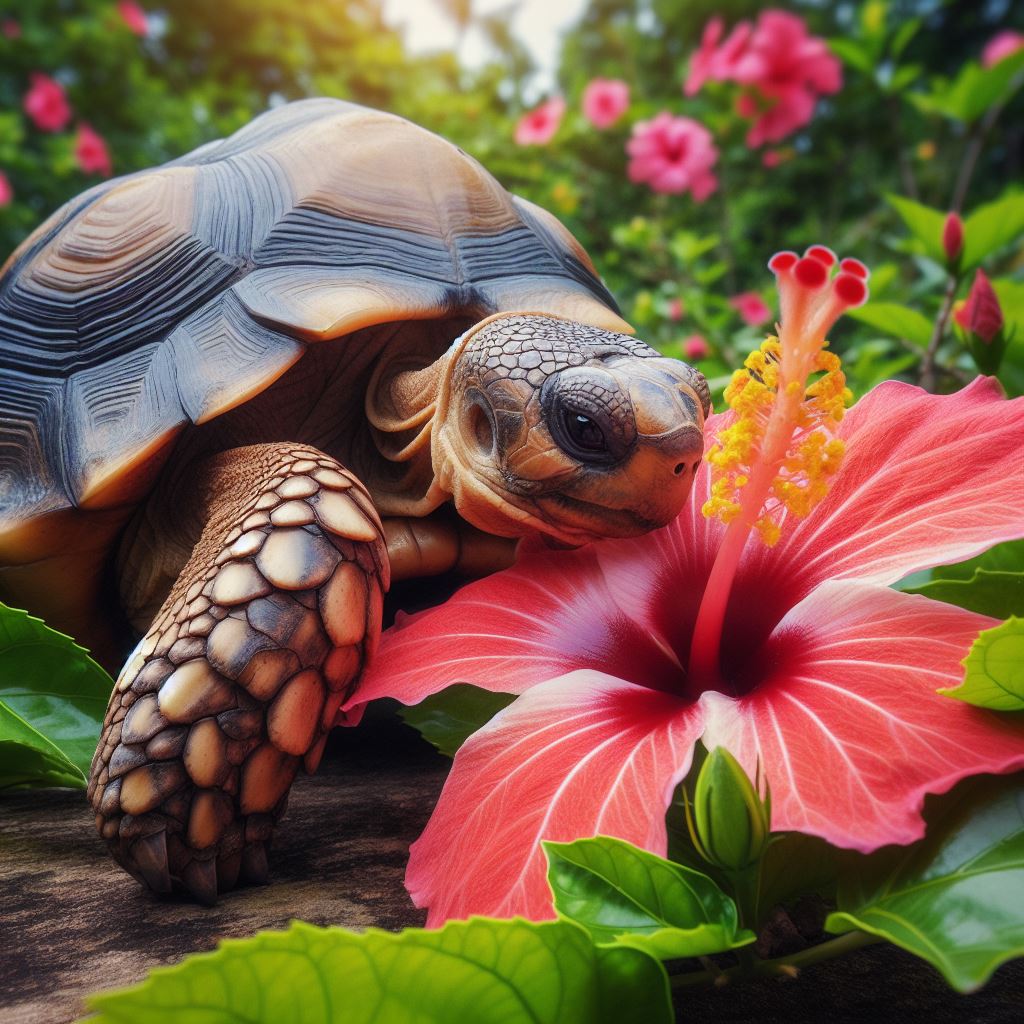
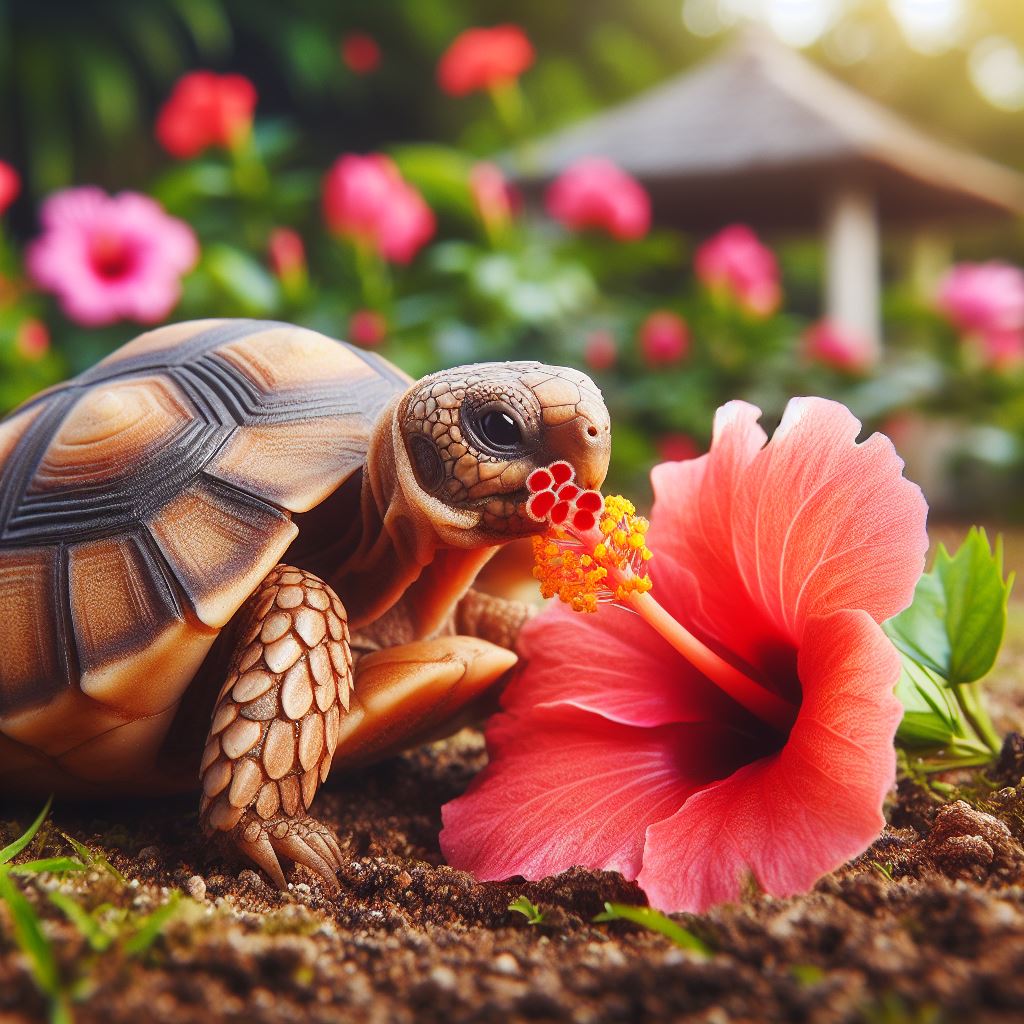
The culinary uses of Hibiscus rosa-sinensis flowers:
Preparation: Before using hibiscus flowers in salads, it’s important to ensure that they are clean and free from pesticides. Rinse the flowers thoroughly in cold water and remove the pistil and stamen, as these parts can be bitter.
Flavor Profile: The flavor of hibiscus flowers can be described as slightly tart and reminiscent of cranberries. This unique taste can add a refreshing and exotic element to salads.
Colorful Addition: The vibrant colors of hibiscus flowers, which range from shades of red and pink to orange and yellow, make them a visually appealing addition to salads. The petals can be used to enhance the overall aesthetic of the dish.
Culinary Creativity: Beyond salads, hibiscus flowers can be used to make teas, jams, syrups, and even incorporated into desserts. The petals can also be candied for a sweet treat.
How to brew Hibiscus rosa-sinensis tea
Making hibiscus tea, also known as hibiscus herbal tea or sorrel tea, is a simple process. Hibiscus tea is known for its vibrant red color and tart, fruity flavor. Here’s a basic recipe for making hibiscus tea:
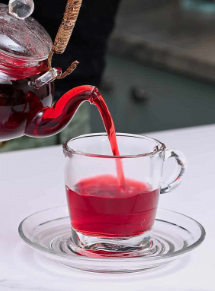
Ingredients:
- 1/4 to 1/2 cup dried hibiscus petals (dried hibiscus flowers)
- 4 cups water
- Optional: Sweetener (honey, agave syrup, sugar), lemon or lime wedges, mint leaves for garnish
Instructions:
Rinse the Hibiscus Petals: If the hibiscus petals are not pre-rinsed, give them a quick rinse under cold water to remove any dust or debris.
Boil Water: In a pot, bring 4 cups of water to a boil. Make sure the water is fresh and clean.
Add Hibiscus Petals: Once the water is boiling, add the dried hibiscus petals to the pot. You can adjust the amount of hibiscus petals based on your taste preferences. If you want a stronger tea, use more petals.
Simmer: Reduce the heat to low and let the hibiscus petals simmer in the water for about 10-15 minutes. This allows the flavor to infuse into the water.
Strain the Tea: After simmering, remove the pot from heat and strain the tea to remove the hibiscus petals. You can use a fine mesh strainer or cheesecloth for this.
Sweeten (Optional): If desired, sweeten the tea to taste while it’s still warm. Add honey, agave syrup, sugar, or any sweetener of your choice. Stir until the sweetener is completely dissolved.
Cool and Serve: Allow the tea to cool to room temperature, then refrigerate it until chilled. You can serve the hibiscus tea over ice with lemon or lime wedges and mint leaves for garnish.
Enjoy: Once the tea is chilled, it’s ready to be enjoyed! Hibiscus tea can be served as a refreshing cold beverage or warm depending on your preference.
Resources
https://gardeningsolutions.ifas.ufl.edu/plants/edibles/vegetables/roselle.html
https://www.fona.com/articles/2020/07/flavor-insight-hibiscus
